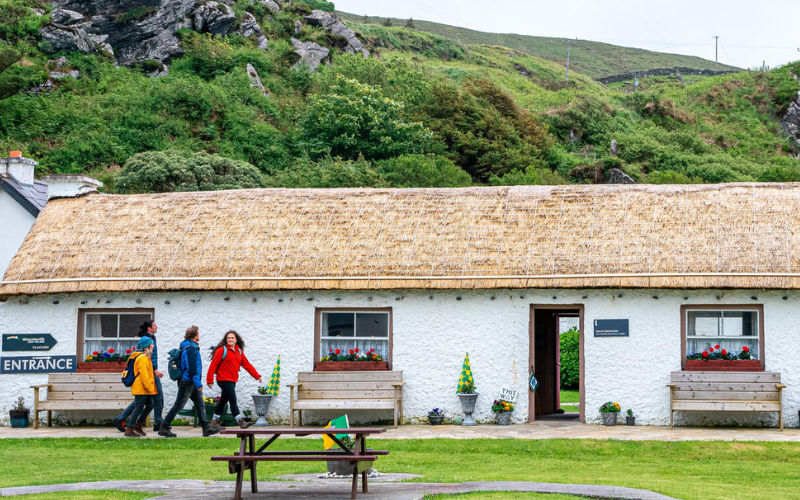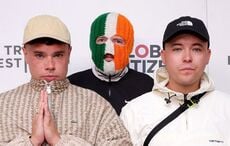| Joel Hanna, Irish dancer and choreographer |
"Listen to your teachers...shut up and dance!"
~Joel Hannah
Joel Hanna is well known throughout the world for his innovative Irish dance techniques. A Vancouver, B.C. native, Joel began his Irish dance training at the age of nine. He launched his career and joined "Riverdance" in 1997, after which he joined the original stars of the show, Colin Dunne and Jean Butler, to perform in "Dancing on Dangerous Ground". He has taught and choreographed all over the world, spreading his love of dance, percussion, and martial arts. In May of 2013, Joel was involved with the dance choreography of young Schuyler Iona Press's production, "What I'm Failing to Learn". He soloed and choreographed in "Pastures", a Woodie Guthrie piece that was selected as a New York Times pick of 2012. Joel most recently finished a performance of "Choreography on The Edge" to sold out audiences in Woodstock.
| Joel Hanna |
Christy: How did you get started in dancing?
Joel: That's a bit of a story. I started doing Philippino folk dance when I was about five, and then quit for the same reasons any toddler does anything—something shiny caught my attention. Whether it was kung fu or Transformers, I don't know, but I ended up a couple years later fumbling into an Irish dance class with my sister. My dad is Irish, so it was kind of a no brainer. But, back then it was different. Irish dance was still a thing that you only did because your family was Irish, or at some point claimed to be. So, to be this little half-Asian thing, bouncing around in a kilt at feiseanna all over the place must've been a sight to see. I started doing pretty well and traveling a lot to compete, so the cockeyed skeptic quickly jumped on board. From there, to somehow ending up in Riverdance, Dangerous Ground, becoming a principal in Fire, and then starting to produce and getting to be myself all the time, it seems like a life time ago.
Christy: What is it about Irish dancing that draws you?
Joel: Wow. That's an interesting question. In it's traditional form, I think the universal appeal of Irish dance comes from the music. There is something charming and fetching about Irish music that is infectious--that much is undeniable. And now, thinking back to when I was a kid growing up with this, there's something really special about the innocence of it. This ancient form of spectacle and social dance has made it through thousands of years of cultural evolution without changing much (until the last few decades really), and was a closely guarded secret. Now, I want to see what can be done with it. I believe that it has the ability to be as much of a relevant form of contemporary movement as any other dance form. The traditional form and competitive system of Irish dance will always be there, and I believe it should be. I disagree with people who say that it needs to change and evolve. I don't think it does. I believe that it is the text book that we need to build our foundation from as dancers, and to master the vocabulary handed down by the generations before us. But I believe Irish dance is at a critical point, and the future of it excites me.
Christy: Your style of teaching and performance has been called innovative. What is it about your style that is unique?
Joel: Really? That's very generous, thank you. I guess it's because I like to do things in my weird way. I think a lot about philosophy when I start on projects and new works, and I get inspiration from a whole whack of places and people. Bruce Lee is a great one for me, not just physically though. His words, I believe, have application in life as a whole. But we're all different, and everyone comes from their own background and experience.
I don't know really, I just know that it works. When I'm working with dancers, especially competitive dancers, I work on "them" much more than the material that they are doing. I think that the fundamental mechanics of their own bodies is a much more important subject to focus on. Technique depends on it. How can a dancer of any kind have any technique if they don't have the facilities to support technique? I use a combination of kung fu strengthening and stretching methods with ballet training to condition dancers, and myself. I won't say who's method is right or wrong, or that mine is any better, but I know it works, and it works fast.
I know that my life and career have been a sort of fairytale. I find it hard to take in sometimes. Between the things that I've gotten to do that came out of nowhere, and the things that we put ourselves through hell for, a lot of it seems surreal sometimes, and I don't know why I've been lucky enough to live it.
Christy: How did you meet Schuyler Iona Press, and what made you decide to be involved in the production of "What I'm Failing to Learn"?
| Joel Hanna |
Joel: I first met Sky when she was really little. She was just this tiny little thing in a school that had brought me in to do a workshop and set a choreography on. I had no idea that there was this magical little thing in the room at the time. I'd seen her sporadically in the last few years and heard about her developing talent, so when I was approached to be a part of this project, of course I had to say yes. The idea being so out of left field, and interesting, to the point that I didn't know if I'd be able to do it, is what really caught my attention. Whenever a challenge comes up like this, I know that no matter how it ends up manifesting itself in the end, it's going to be interesting, and a surprise worth waiting for.
Christy: How did it feel to perform for to a sold out audience in Choreography on The Edge?
Joel: It was wonderful—and terrifying! I always get really nervous when putting out a new piece like that.We got an wonderful review from the New York Times, "The spark of Joel Hanna’s tapping and clogging, like the sheer panache of his performance, was utterly winning, but his camaraderie was equally so," and the piece was later selected as one the NY Times picks of 2012. It was one of my favorite things to do.
Christy: What are your thoughts about the future of Irish dance performance?
| Joel Hanna |
Joel: I wish I could see into the future and come up with an answer that doesn't make me sound like an idiot, but I can't. But I have hopes for Irish dance, and whenever I wonder about what is going to happen, there are words from some of the greatest dance icons in history that make me feel excited to see it. Ted Shawn said that "Dance is the only art of which we are the stuff of which its made", and Martha Graham said that "It is a barometer telling the state of the soul's weather to all who can read it." I know both of those ideas to be true. And I know that I would do this whether there was anyone there to notice or not. So, I guess I think that as long as the heart and soul of the people Irish dancing is in the right place, I can look to the future with curious excitement. But even then, I can only tell you where my heart and soul will be.
Christy: Are there any other projects, recent or future that you are willing to tell us about?
Joel: The next season is crazy for me. I think I'm going to be on almost every continent in the next year. I have some exciting new collaborations in China, with a new collection of repertoire coming out in North America. There's a wonderful outreach program this December in India that I can't wait for (I love doing outreach work) and in the New Year I'll be back in Europe for a few months. We're only half way through this year and I'm chomping at the bit to dig into next season.
Christy: What advice do you have to Irish dancers who are just starting out?
Joel: Shut up and dance. Learn as much as you can, keep what works for you and throw away what doesn't. Listen to your teachers, and don't ever think that there's such a thing as "too much practice". And no matter what happens, or what people say, don't you ever, ever, ever quit.
*all photos are kindly provided courtesy of Joel Hanna
Readers: Are you an Irish dancer or a dance school, competitive or not, with a story to share? Would you like to inspire others to feel your passion for Irish dancing and culture? Do you have a question about Irish dancing? Please visit www.christydorrity.com.




Comments